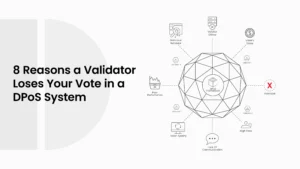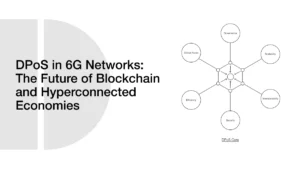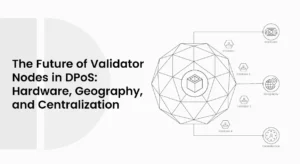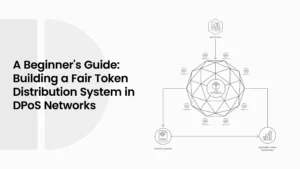Hybrid Governance Models: Blending DPoS with Traditional PoS
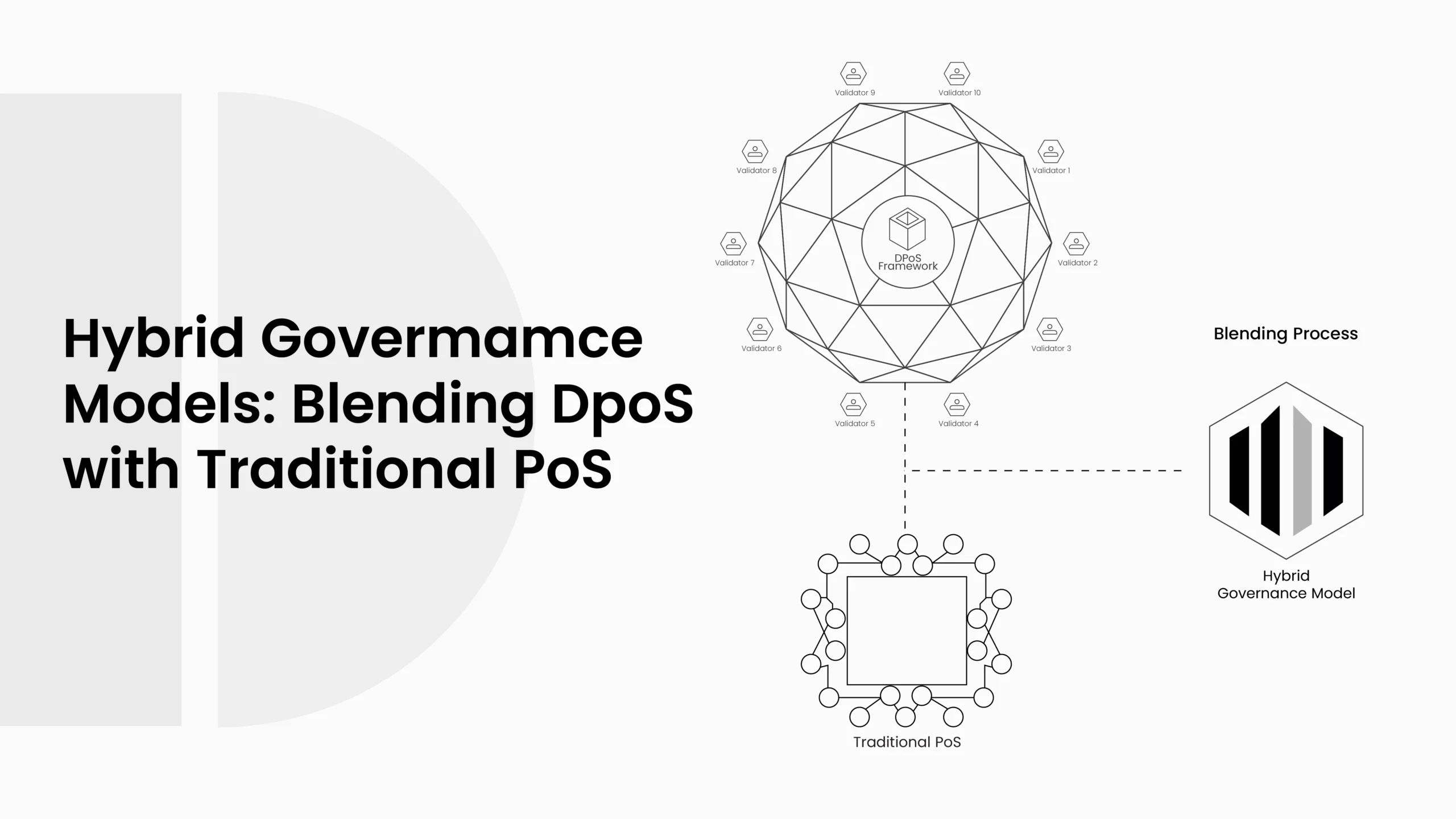
Blockchain is like a big record book that is shared by many computers. Nobody owns it alone, and no single company controls it. For the system to work, all computers must agree on which transactions are true. This agreement originates from a consensus algorithm.
- What Is Proof of Stake (PoS)?
- What Is Delegated Proof of Stake (DPoS)?
- Why Are Hybrid Governance Models Needed?
- PoS vs DPoS vs Hybrid Models
- How Hybrid DPoS + PoS Works in Practice
- Voting and Validator Selection
- Block Production and Verification
- Example Flow in Simple Words
- Attack Resistance in PoS, DPoS, and Hybrid
- Benefits of Hybrid Models
- Better Security
- Improved Fairness
- Efficiency and Speed
- Stronger Governance
- Challenges of Hybrid Governance
- Complexity
- Voting Fatigue
- Governance Capture
- Challenges vs Solutions in Hybrid Governance
- Case Studies and Examples
- Academic Reference Models
- Industry Experiments
- Lessons From These Examples
- Future of Hybrid Consensus
- Adoption in Smart Cities and IoT
- Role in Finance
- Long-Term Scaling
- Use Cases for Hybrid Governance Models
- Conclusion
- Frequently Asked Questions About the Hybrid Governance Model
- What is a hybrid governance model in blockchain?
- Why not just use PoS or DPoS alone?
- Is hybrid governance safe from attacks?
- Where can hybrid models be used?
- Glossary of Key Terms
Two of the most common algorithms are Proof of Stake (PoS) and Delegated Proof of Stake (DPoS). PoS chooses validators based on how many tokens they own. DPoS lets token holders vote for a smaller group of people called supernodes to make blocks faster. Both systems have good sides and bad sides.
Some chains are now thinking about mixing both together. This is called a hybrid governance model. It tries to take the fairness from PoS and the speed from DPoS, then joins them into one system. The idea is to fix the problems that each one has when used alone.
What Is Proof of Stake (PoS)?
Proof of Stake is a system where computers, called validators, are picked to add new blocks depending on how many coins they hold. The more coins a person has, the more chance they have to be chosen. This is like buying lottery tickets. If you own more tickets, your chances are higher.
PoS was created because Proof of Work used too much electricity. Instead of burning power, PoS uses ownership of tokens to decide who can add blocks. This makes it cheaper and also greener. Many new blockchains today use PoS because it saves resources.
But there are problems too. If rich people hold many tokens, they get chosen more often. They keep getting rewards and become even richer. This can make the system unfair. New users may feel they have no chance to compete. Another problem is forks. Because it costs almost nothing to build on different chains at the same time, PoS can sometimes split into two versions.
ALSO READ: Why Some DPoS Chains Thrive While Others Fade Away
So PoS is good for saving energy and giving fast confirmations, but it is weak when it comes to fairness and avoiding monopoly.
What Is Delegated Proof of Stake (DPoS)?
Delegated Proof of Stake is like PoS but with voting added. In this system, people who own tokens do not all validate directly. Instead, they vote for a small number of representatives called supernodes. These supernodes then take turns making blocks and checking transactions.
DPoS is faster because only a few nodes are working. Blocks can be made every few seconds. It is also cheaper since not everyone has to run heavy computers. For normal users, it is easy because they just vote and then let supernodes do the work.
But there are weak points too. Since only a few supernodes are in charge, the system can become centralized. If supernodes work together in a bad way, they can control the network. Also, voting is not always perfect. Sometimes only a small part of the community votes, which means power can end up in the hands of a few people.
DPoS is popular because of its speed, but many experts say it sacrifices some decentralization.
Why Are Hybrid Governance Models Needed?
Rich token holders get more chances and keep winning. This makes the network look like it belongs to the few. On the other hand, DPoS is fast, but it has less decentralization. It puts trust in a small group of supernodes. If they join together or act badly, the whole chain is in danger.
Real blockchain use cases today need more balance. They need to be fast, safe, and also fair. No single system gives all of these things. That is why people are talking about mixing both PoS and DPoS into one model. This is what’s called hybrid governance.
In hybrid models, you take the fairness of PoS and the efficiency of DPoS, then you join them. For example, PoS can be used to pick validators in a fair way. Then DPoS can help by making block production fast and easy. Together, they cover each other’s weak points.
This idea also makes attacks more costly. To break a hybrid system, an attacker would need both a large amount of tokens and also control of voting power. This is much harder to do than just buying coins or running computers. It raises the safety level of the blockchain.
So, hybrid governance is not just a theory. It is a practical step to make blockchains ready for real life. From finance apps to smart cities, hybrid models can give the mix of security and speed that is needed.
PoS vs DPoS vs Hybrid Models
| Feature | Proof of Stake (PoS) | Delegated Proof of Stake (DPoS) | Hybrid (PoS + DPoS) |
| Speed | Medium, slower than DPoS | Very fast, blocks in seconds | Fast like DPoS, but with checks |
| Fairness | Can favor the rich | Depends on voting, not always fair | More fair, a mix of both |
| Decentralization | Medium, but rich control | Low, a few supernodes control | Better balance of power |
| Energy use | Low, green | Low, green | Low, same as PoS |
| Attack resistance | Needs 51% of tokens | Needs control of supernodes | Needs both tokens and voting |
How Hybrid DPoS + PoS Works in Practice
Voting and Validator Selection
In a hybrid system, token holders still play a role similar to that in PoS. They put their tokens into the system, and this gives them voting rights. However, instead of directly choosing validators, they also employ voting, similar to DPoS. This means that some validators are selected randomly based on stake, while others are chosen through community voting. It feels like a mix between a lottery and an election.
This way, the system keeps fairness, because even smaller holders have a chance through PoS rules. At the same time, the network gets efficiency because DPoS-style voting brings in supernodes that are ready to process blocks quickly.
Block Production and Verification
Once validators are selected, the work is split. The DPoS supernodes can handle block creation since they are optimized for speed. But before a block becomes final, PoS validators can check it. This second layer of checks makes sure no single group has all the power.
It is almost like one group is writing the record, while another group is reviewing it. Both sides must agree before it is accepted. This mix makes cheating much harder and also keeps the process fast.
Example Flow in Simple Words
Think of it step by step. First, a user sends a transaction. Then, PoS validators and DPoS supernodes get the request. The DPoS side makes the block quickly. Before it is final, the PoS side does the check. If both sides agree, the block is added to the chain. If not, it is rejected and a new one is made.
ALSO READ: How Yield Wars Between Validators Distort DPoS Ecosystems
This step-by-step way makes sure speed is not lost, and fairness is not lost too. It is not perfect, but it strikes a balance between both worlds.
Attack Resistance in PoS, DPoS, and Hybrid
| Attack Type | PoS Alone | DPoS Alone | Hybrid (PoS + DPoS) |
| 51% Attack | Attacker needs 51% of tokens | Attacker needs control of supernodes | Attacker needs 51% tokens + supernode control |
| Sybil Attack | Easy if rich hold many accounts | Limited by voting but still possible | Much harder, must fool both systems |
| Collusion Attack | Rich groups can collude | Supernodes can collude | Collusion must happen in two layers |
| Double Spending | Medium risk, forks possible | Lower risk, butit depends on supernodes | Very low risk, double check needed |
Benefits of Hybrid Models
Better Security
Hybrid governance makes blockchains harder to attack. In PoS alone, an attacker just needs to buy or control 51% of all tokens. In DPoS, the attacker only needs to get influence over the supernodes. But in a hybrid model, they need both at the same time. This makes it very costly and almost impossible for bad actors. The system becomes safer for users.
Improved Fairness
PoS often gives more power to rich token holders, while DPoS may put too much power in the hands of few supernodes. But hybrid blends them. Even smaller token holders can play a role, because PoS keeps their chance alive. DPoS also keeps the chain running fast. Together, it stops monopoly from forming too easy.
Efficiency and Speed
One of the best things in DPoS is speed. Blocks can be confirmed in seconds. Hybrid keeps this speed, but with an added PoS check. So the network does not become slow like old Proof of Work chains. People using the blockchain can still enjoy quick transactions, while knowing there is extra security behind it.
Stronger Governance
Governance means how rules are made and followed in the network. Hybrid governance mixes voting with staking. Users feel more included, and they know there is more balance. This makes decisions in the blockchain more trusted. It gives both community and leaders a role to play.
Challenges of Hybrid Governance
Even if hybrid models sound strong, they also face some problems.
Complexity
The system has more rules than PoS or DPoS alone. It may be harder for new people to understand. Complex rules can also bring bugs in the code. This makes it risky if not tested well.
Voting Fatigue
In hybrid models, users may need to vote often, or delegate votes. Many users don’t care enough to vote all the time. If only a small group votes, the system may again look centralized.
Governance Capture
Even if hybrid is designed to stop monopolies, big players may still find ways. They can buy tokens and also try to influence votes. If this happens, then hybrid may still face same issues as pure PoS or DPoS.
ALSO READ: DPoS as an Economic Laboratory: Incentives, Rewards, and Risks
Challenges vs Solutions in Hybrid Governance
| Challenge | What It Means | Possible Solution |
| Complexity | Users find rules too hard | Better education and simple interfaces |
| Voting Fatigue | People stop voting | Incentives for voters, auto-delegation |
| Governance Capture | Big players still gain control | Limit vote weight, random validator mix |
Case Studies and Examples
Academic Reference Models
Researchers have already tested hybrid consensus ideas. One study by Wang, Li, and Li (2020) looked at mixing Delegated Proof of Stake with a modified Proof of Probability model. In their design, block generation was done by probability-based nodes, and block verification was done by elected DPoS supernodes. This mix raised the cost of attacks, reduced waste, and made the system more fair. Their results showed the hybrid could reach a better balance in efficiency, security, and decentralization (Wang, Li, & Li, 2020).
Industry Experiments
Some newer blockchains also experiment with various hybrid models. They combine PoS fairness with the fast block times of DPoS. In practice, this means users can still stake their coins, but they also join in voting for validators. Some gaming chains and financial platforms already test hybrid ideas because they need both speed and strong protection against cheating.
Lessons From These Examples
The main lesson is that no single model fits all. But hybrid designs can cover the weak points of both PoS and DPoS. By splitting the job between two layers, the system gets more reliable. While still new, these experiments show hybrid governance is not just a theory. It is moving toward real adoption.
ALSO READ: Token Concentration and Power in DPoS: Can Whales Dictate Validator Outcomes?
Future of Hybrid Consensus
Adoption in Smart Cities and IoT
Smart city systems and the Internet of Things need fast but also safe blockchain networks. A hybrid model can ensure that devices can communicate with each other quickly, while also maintaining strong security. DPoS gives speed, and PoS makes sure power is spread more fairly.
Role in Finance
Banks and payment systems want both safety and high performance. Hybrid governance can give them both. With PoS, no single bank can control the chain. With DPoS, transactions can be confirmed in seconds. This makes hybrid governance attractive for real financial adoption.
Long-Term Scaling
The biggest question for blockchain is how to scale to millions of users. Hybrid governance could help here. It allows a balance between speed and decentralization. It also spreads risk across two systems. This might make it better suited for a global scale than PoS or DPoS alone.
Use Cases for Hybrid Governance Models
| Use Case | Why Hybrid Works Here | Key Benefit |
| Finance | Needs both safety and fast payments | Secure payments in seconds |
| Smart Cities | Millions of devices need trust and quick action | Fast data checks, fair governance |
| Supply Chain | Many players, need fairness and tracking | Transparent and efficient |
| Gaming | Quick actions, but no cheating allowed | Speed plus trust in rules |
Conclusion
Hybrid governance models are becoming an important step in blockchain. PoS brings fairness and energy saving. DPoS brings speed and low cost. But each one alone has weak points. By blending them, blockchains can get the best of both. Security is stronger, attacks cost more, and normal users feel more included.
The idea is not perfect. Hybrid models are harder to manage, and sometimes users may not vote much. But still, this balance of speed and fairness makes it one of the most promising directions for blockchain in the future.
Frequently Asked Questions About the Hybrid Governance Model
What is a hybrid governance model in blockchain?
It is a system that mixes Proof of Stake and Delegated Proof of Stake. It uses PoS for fairness and DPoS for speed.
Why not just use PoS or DPoS alone?
Because each one has limits. PoS can become unfair for small users. DPoS can become centralized. Hybrid tries to fix both.
Is hybrid governance safe from attacks?
Yes, it is safer than using one system. Attackers need both tokens and voting power at the same time, which is very costly.
Where can hybrid models be used?
They can work in finance, smart cities, supply chain tracking, and gaming. These areas need both speed and trust.
Glossary of Key Terms
Blockchain – A shared record book that is stored on many computers.
Consensus Algorithm – A rule that decides how all computers in blockchain agree on which transactions are real.
Proof of Stake (PoS) – A method where validators are chosen based on how many tokens they own.
Delegated Proof of Stake (DPoS) – A method where users vote for a small group of supernodes to make blocks quickly.
Validator – A computer in the network that checks and confirms transactions.
Supernode – A special node in DPoS that is chosen by votes to make new blocks.
51% Attack – When someone controls more than half the system and tries to cheat.

